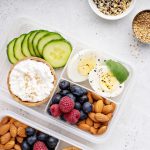
Top Ten Tips for Eating Healthy
Ten (Easy) Methods You Can Eat Healthier
No matter what kind of diet you follow, these tips will help you eat healthier and get the most nutrition out of your food!
Eating healthy can feel like a challenge sometimes, with the stresses of school, work, family and the pressure to lose weight (imposed by ourselves, or society) holding us back from giving more attention and care to our diet. Focusing on how you feel instead of how you look is one of the keys to healthy eating. Another important thing to focus on is getting more nutrition out of your food – that is, vitamins, minerals and other nutrients that help your body perform, heal and grow.
You may not realize it, but the way you currently cook and prepare your meals might not be extracting the most potential out of your food – or, you could even be damaging the nutritional quality of your food. You may also be missing out on the right amounts of essential nutrients such as fibre and healthy fats that can help with weight loss, blood sugar control and healthy digestion. This article will explain 10 ways you can start eating healthier and feeling better to support your overall well-being and weight loss goals!
- Use Vegetables as a Base for Your Meals
The Western diet often focuses meals around some kind of protein, such as chicken, beef or pork. However, meat doesn’t provide everything our body needs to function and this often means that healthy fats, fruits and vegetables take a backseat. For a well-balanced meal, you should aim to have at least half of your plate consist of vegetables. Vegetables are a source of dietary fibre; they are important for healthy digestion, blood sugar control and helping you feel fuller longer. They are also a rich source of essential nutrients and vitamins that help improve bodily functions, slow aging processes, improve your skin and nails and prevent certain diseases.
Vegetables are also a great way to replace refined carbohydrates in your meals, especially if you follow a carb restricted diet. Check out our articles about Low Carb Potato Substitutes and Keto Pasta Substitutions.
Here are some more ideas for how to base your meals around vegetables:
- Miracle Noodle is a low carb substitute for pasta noodles made from the root of the konjac plant, which has high fibre and water content with few calories and net carbs.
- Ground or mashed cauliflower can be made with a food processor or bought pre-riced.
- Kelp noodles are the richest natural source of iodine and are high in other vitamins and minerals, plus they are low in calories and carbs.
- Spaghetti squash is a low carb root vegetable that resembles spaghetti noodles once cooked.
- Zucchini, onions, fennel, turnip, kohlrabi, beets and carrots can be made into “noodles” with a kitchen spiralizer.
- Add Flaxseed to Your Meals for a Boost of Fibre
Fibre is important to have with every meal to ensure proper digestion and cease feelings of hunger. While vegetables are great sources of both soluble and insoluble fibre, sometimes they are not the best pairing with every meal. It can be easier to add other forms of fibre, such as ground flaxseed, to things like smoothies, cereals, yogurt and home-baked goods. Flaxseed is also a great source of omega-3 fatty acids, which support heart health and brain function.
It is important to buy ground flaxseed or grind it yourself at home. Breaking down the seed’s protective outer shell makes it easier for our bodies to digest and extract nutrients. Anthony’s Organic Flaxseed Meal comes in a convenient resealable bag which is perfect if you don’t have a food processor or blender to grind your own flaxseed.
Some other natural fibre supplements you can look for include ground chia seeds, psyllium husk powder and oat fibre.
- Let Your Vegetables Sit After Cutting Them
This seems like a strange tip, but letting your vegetables sit after cutting them can allow certain enzymes to activate which help convert nutrients into a more usable form. It is a good idea to leave your cut vegetables out for 10-15 minutes before cooking them. You might be thinking that this sounds like a lot of extra prep time for cooking, but you can simply chop your veggies first and prepare the rest of your meal while they sit. Some vegetables that really benefit from this technique are broccoli, onion, garlic and kale.
- Eat Vitamin C-Rich Foods Along with Iron-Rich Foods
Another way to enhance the nutritional value of certain vegetables, especially those high in iron (think dark leafy vegetables), is to eat them along with a source of vitamin C such as a squeeze of lemon juice or other citrus fruits. Vitamin C helps the body absorb iron more efficiently, and iron is essential for several important processes in the body including the transportation of oxygen through the blood. This is a great healthy eating tip that is not only easy but also improves the taste of your food! The acidity from citrus fruits can brighten and balance a dish without the use of high carb, high calorie sauces and dressings.
- Eat Enough Good Quality Fats
Fat helps with absorption of many fat-soluble vitamins such as A, D, E, and K, that your body needs to carry out essential functions. Whether you are on a ketogenic diet or not, it is important to ensure you are eating enough fats from good quality sources. Plant-based sources of unsaturated fats are some of the best options. These include avocados, nuts, seeds, coconut and olive oil. Fatty fish and eggs also provide different kinds of healthy fats that are essential to the body. Consuming fats from these sources will improve your hormone health, skin, brain function and balance blood sugar levels throughout the day.
- Have Balanced Meals and Snacks
Make sure your meals and snack foods consist of fats, fibre and protein. Having a balance of these different macronutrients will not only increase satisfaction with your meal, but also ensure that you are getting the variety of nutrients that your body needs. This will also help control blood sugar levels as imbalanced meals that are heavy on carbohydrates and low in fat & fibre will destabilize blood sugar.
- Smoothies!
If eating healthy feels like a challenge for you, smoothies are a quick and easy way to make sure you are getting enough nutrients in your diet. You can pack them full of different fruits, vegetables, fibre, protein (whey or vegan) and healthy fats. Blending also makes smoothies easy on your digestive system and can be especially great in the morning for a light and nutritious start to the day.
Some superfood additions to your smoothies could include hemp seeds, chia seed, flaxseed, algae and seaweed powder and high antioxidant berries (such as blueberry, blackberry, cranberry, acai and aronia berry). Nut butters and avocados can make your smoothies thicker and more filling. Frozen vegetables such as cauliflower and zucchini are also great low carb additions that you can use instead of ice cubes to really pack the nutrients into your smoothie.
- Cook with Good Quality Oils
Good quality oils are an extremely important part of cooking. Choose oils that are stable at high temperatures (often solid at room temperature) and don’t have a high omega-6 to omega-3 ratio (over 10:1). Stable oils won’t produce toxins when heated at high temperatures that can potentially increase your risk of certain diseases. They usually contain more monounsaturated fats, which are one of the healthiest kind of fats to consume. Plus, they won’t produce a bitter or unpleasant taste when cooked.
Some great cooking oils include:
- Coconut oil (which also has many other uses for home and beauty!)
- Extra virgin olive oil
- Ghee
- Avocado oil
It is best to avoid any oils labeled as “hydrogenated” or “partially-hydrogenated” as these are stripped of their original nutrients, high in trans fats and can raise levels of bad LDL cholesterol. Oils higher in polyunsaturated fats such as sunflower, safflower and flax oils are also better used in dressings rather than cooking.
- Steam Veggies Instead of Cooking Them in Oil
Steaming is a quick and easy way to cook your vegetables that preserves more of their natural colour, flavour and nutrients compared to cooking them in oil. Simply add a splash of broth or water to a hot pan with your veggies and watch as the colours intensify and the vegetables soften. Steaming can also help you control your intake of fats more easily as it can sometimes be hard to keep track of how many calories and fat are added to a meal when using cooking oils.
- Chew Your Food!
Our last tip is the simplest one yet of the most effective ways to improve your digestion and nutrient absorption from your food! Chewing your food helps break it down into smaller, more easily digestible pieces. It also increases the surface area of the food in your mouth, which allows enzymes in your saliva and stomach to help break it down and extract nutrients. So, next time you sit down for a meal remember to chew and eat mindfully!
Enjoy Low Carb Foods
If you enjoyed learning about these 10 ways to eat healthier, or have any other tips of your own to share with our community on how you cook and eat low carb foods, head over to our Facebook page or tag us on Instagram!
You’ll find the best selection of low carb foods at the Low Carb Grocery, so be sure to look around and see some of the unique products we carry. And don’t forget to leave us a Google Review with your Low Carb Grocery experiences after you’ve received your order!






